Relish Every Leaf!
My aim here is to highlight how to prune and harvest your culinary herbs for a robust garden-to-kitchen experience. We humans use and have always used our garden herbs to enhance the flavor of the food we all eat. Herbs are so embedded in our lives that we have done this for thousands of years, and today, every culture around the world is cooking with herbs right now.
Somewhere, someone is always cutting herbs for the cookpot!
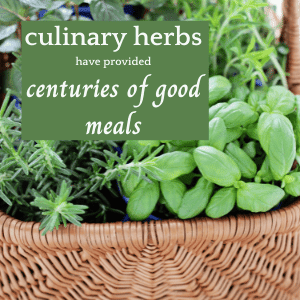
Consequently, it is important to understand that the way in which we prune, cut, and harvest the herbs we grow will dictate the pleasure and success we enjoy in doing so.
Pruning and harvesting is the universal technique in using herbs, no matter if we grow them on a windowsill, patio container, or garden.
Do Not Let The Size Of Your Growing Space Dictate Your Ambitions
If you like the idea of growing herbs for your kitchen, you can do it no matter how limited your space is. Herbs are small and simple plants. For centuries, people have simply picked them in the wild for the cooking pot or home remedies. They require little space. You can grow some for cooking, in a space beside the kitchen door or on the patio. Many cooks in every culture have found a way to grow what is needed. You can too!
Practicing What I Preach
I am a volunteer Master Gardener in my community, a lifelong gardener, and a descendant of a family with a long tradition of boots in the dirt. As soon as I finish writing this, the rosemary needs attention.
How To Prune And Harvest Your Herbs And Relish Every Leaf
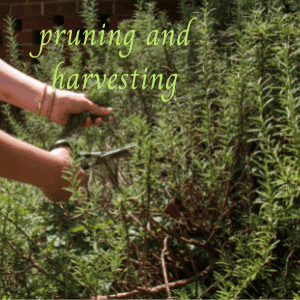
The way that we prune and harvest and our timing in doing so can extend the useful lives of these herbs and the flavors we get from them.
Pruning from the parent plant can even give us a succession of new plants to keep the party going.
Principles Of Pruning Herbs
Prune and harvest your herbs with a sense of purpose. You will do the job best if you are working toward a goal.
Here Is That Goal
- Prune to maintain a healthy size and shape. These are smaller plants both perennial and annual and the goal is a rounded shape, wide and solid. Your goal is to create short internodes, (stems between the leaves) with plenty of leaves to harvest. Herbal flowers are delightful, beautiful and tasty but they come at a price. Read on for reasons.
- Never remove more than 1/3 of the plant mass.
- Observe and prune your plants frequently. You can begin to prune herbs when you have a good set of stems about 6″ in height., Regular pruning insures that you are looking at and handling your plants. If there are pests or diseases you will catch them early enough to stop them. For issues affecting each herb read the pages on individual herbs. I have some links below.
- When you begin to see signs of pests and diseases, immediately remove the affected plant parts. You can cut them off or use a hard spray of water from the hose. We are trained to practice and teach IPM (Integrated Pest Management). This is the progressive response to problems with growing plants and it is taught in every Agricultural College throughout the world.
- Prune to make new plants. Many herbs are surprisingly easy to propagate. This keeps fresh herbs readily available for the kitchen, it saves you money and doing your own propagation makes gardening more interesting.
- Prune to harvest. Grow your herb plants in locations convenient to the kitchen. I usually plan my day’s menu in the morning and I like to pick the herbs while the dew is still on them to store for the day in a glass of water. It’s a useful bouquet for the kitchen! Read on for “how to.”
- Prune from the top. This encourages a wider, more dense and stable plant.
When To Prune (And Not Prune) Your Culinary Herbs
You will prune herbs steadily through the growing season, indoors or out but there are some issues to be aware of.
- Begin to prune in spring, when you have new growth but after your last anticipated freeze.
- Prune as late as 8 weeks before your anticipated first fall frost. It is new growth that is most susceptible to cold damage. Here is a service that will help you identify your frost dates.
- Prune regularly, to prevent the herb from flowering. When your annual herbs flower they are beginning to set seeds and end their lives. When any herbs begin to flower, they transfer energy to that activity and the foliage flavor begins to become bitter.
- If you use the herb flowers in bouquets, soups, salads and garnishes you might grow a separate plant for that purpose. Shortening the plant’s life is the price for the flower. Seems fair enough!
What Simple Tools You’ll Need
Cut your fresh herbs with micro pruners, with short, sharp blades, or even with scissors. If you need your regular garden pruners you have probably waited too long. But late is always better than never. Today, I pruned a neglected rosemary plant.
Sterilize The Cutting Tools
I suspect that most of us kill our plants by transmitting pests and diseases by well-meaning care with dirty tools than any other method.
Clean cutting tools on a regular basis with a disinfectant. Gardeners use special products for this purpose or bleach and household disinfectants. What seems most important is having it handy and using it on a regular basis.
How To Harvest And Use Your Fresh Herbs
You can begin to harvest when the plant is large enough to preserve growth, or when the plant is 6-8″ high. During the growing season harvest until the first frost appears. You can take cuttings and grow most herbs indoors. Here is more information on growing herbs indoors.
Use The Right Technique For Different Herbs
Herbs can be subdivided in different ways that affect how we handle them.
Annual, Biannual And Perennial
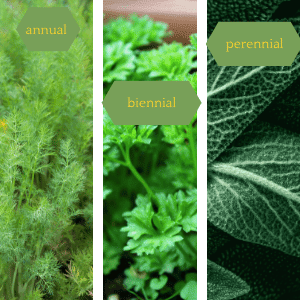
Annual herbs are those that complete their lifecycle in one season. They go from seed to seed in one year. The seeds will regrow.
Annual Herbs
Good examples are:
- Basil: warm weather, fragrant herb. If you love pesto, plant lots.
- Chervil: delicate flavor in the parsley family. Favorite in French dishes.
- Cilantro/Corriander: lemony with a hint of pepper, in the parsely family.
- Dill: unique pungent flavor with a hint of anise.
- Summer Savory: widely compatible, like thyme.
Biennial Herbs
These are herbs that grow leaves, stems, and roots in the first year. In the second, after winter dormancy, they flower, produce seeds, and die. It is a good idea to plant one every year, the flavor and output can change each year.
- Parsley: versatile herb, we have used for 2000 years. High in vitamin A,C & K
Perennial Herbs
The original plant grows or comes back year after year and continually increases in size.
- Bay: leaves are produced by the evergreen sweet bay tree.
- Chives: provide delicate onion like flavor and are usually used raw.
- Lavender: angustifolia, is the sweeter variety and does appear in cooking.
- Marjoram: related to oregano. Use it for a milder and sweeter flavor.
- Mint: there are many varieties, each producing different fruity, aromatic flavor.
- Oregano: aromatic herb with antioxidant benefits.
- Rosemary: valued for a sweet and resinous flavor.
- Tarragon: identified by its thin leaves it is a favorite in French cooking.
- Thyme: use the tiny leaves for their earthy, minty savory flavor.
- Winter Savory: think of it as a piney cross between mint and thyme.
Soft Or Woody Growth Habit
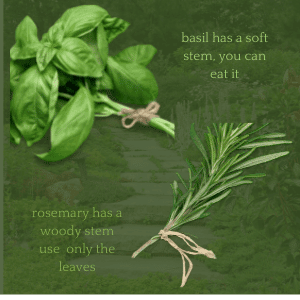
Basil, coriander, and parsley are soft herbs and can be eaten raw.
Rosemary, sage, and thyme are plants with foliage that grows on a woody stem. It gets more woody over time. Add these while cooking, they will give flavor without being eaten.
Cut The Plant To Suit Your Intentions
Cut Herbs For The Kitchen

To shape the plant or cut for the kitchen, cut just above a node (where the leaves join the stem). The plant will use the growth hormone in the node to grow more foliage.
Cut Herbs To Make A New Plant
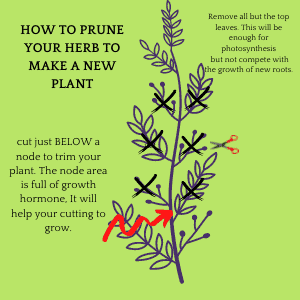
If taking a cutting to make a new plant do this. Cut just below a node, remove all the lower foliage. You can root most herbs in water. It should take about 3 weeks for new white roots to reach over an inch in length. You can plant your new herb at this point.
How To Cut Specific Herbs
Here are some techniques that will help with using herbs.
- For members of the alum (onion) family like chives as there are no branches cut what you require from the outside of the growing stem about 1″ from the base of the plant. As long as the central stem is healthy the plant will keep providing new stems. (/renive abt dried or damaged material as you go.)
- For rosemary, a woody stemmed plant, cut the central stems. This will produce soft new stems to cook with. If you love the idea of using rosemary stems as a flavorful skewer for roasting meat, allow some stems to grow long and heavy enough to cook with. The Tuscan Blue variety of rosemary is good for this purpose as it grows long stems. Do the deepest trimming on rosemary early in the spring before new growth begins.
- Always trim basil to prevent flowering. The flowers are pretty and are edible but once flowers appear the leaves become bitter.
- For herbs like oregano, marjoram and thyme with wiry stems, hold the stem in your hands and simply pull the leaves off.
- To flavor stock and soup you can make a bouquet garni by tying herbs of your choice together with cooking twine. Just take it out when done.
- When you need dill and fennel, cut off the feathery tops and then fold and chop to use in dishes.
- For herbs with wide leaves make a chiffonade. Just roll the leaves like a cigar and slice on the diagonal. This makes a very pretty topping for a dish.
Using Your Herbs In The Kitchen To Cook With
Herbs, both fresh and dried will add flavor to your cooking without preservatives, salt, or fat. You can combine them as you wish to flavor your meals and you can use some herbs in combination to substitute for others.
Fresh Versus Dried or frozen Herbs
The most complex and delicate flavors come from fresh herbs. These are used raw or cooked and are usually put into the cooking pot later in the process. If your recipe calls for dried herbs, use about three times the fresh quantity. Whole herb leaves can be used earlier and removed for service. You can cut and chiffonade the leaves as late additions or garnishes.
Dried herbs are usually more densely flavored, use, less. They are used in cooking, and earlier in the process. An alternative to dried herbs is to freeze them using a little oil or water.
Condiments To Make With Herbs
Try these tasty and simple ideas as a way to preserve and use your herbs.
Conclusion
How Where Your Garden Is Makes A Difference
Most herbs prefer full sun, their water needs differ and it is good to fertilize but not too much as it can create big but flavorless plants.
Convenience is important. Plant as closely as possible to where you cook. If you can get the fresh herbs quickly, you will use them more.
A Summary To Save
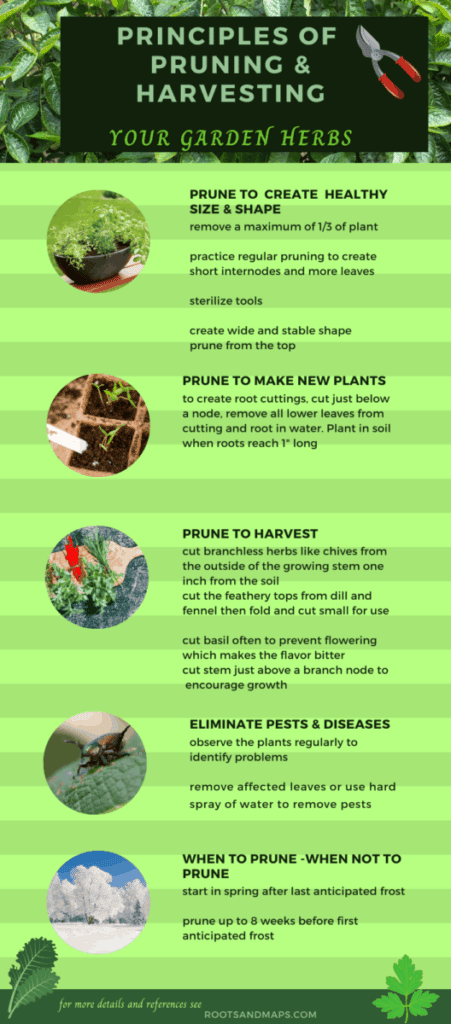
References You Can Use
‘How to Grow Your Own Favorite Herbs for Dinner.’-What I have learned as a Master Gardener and herb grower and cook. It includes links to other related subjects both on my website and to other sources I des
Integrated Pest Management -USDA
Integrated Pest Management University of Florida-This is the IPM information for my climate, from my state university. Wherever you garden your local agricultural University will teach it for you.
How to know your first and last frost dates. This is important to herb growing as pruning encourages new growth which can be susceptible to freeze damage.
